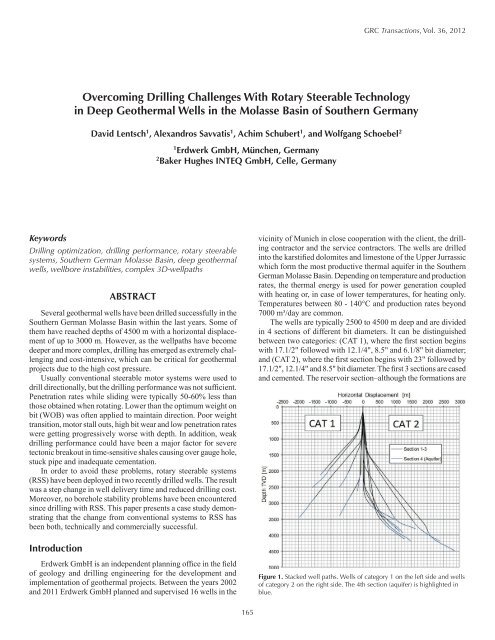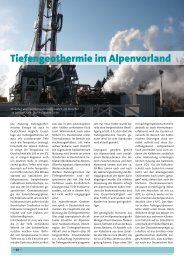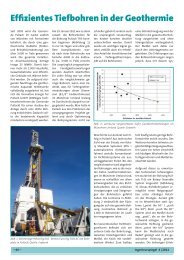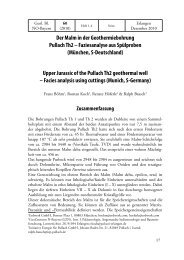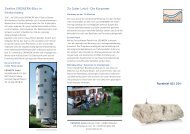Overcoming Drilling Challenges With Rotary Steerable ... - Erdwerk
Overcoming Drilling Challenges With Rotary Steerable ... - Erdwerk
Overcoming Drilling Challenges With Rotary Steerable ... - Erdwerk
Create successful ePaper yourself
Turn your PDF publications into a flip-book with our unique Google optimized e-Paper software.
Keywords<br />
<strong>Drilling</strong> optimization, drilling performance, rotary steerable<br />
systems, Southern German Molasse Basin, deep geothermal<br />
wells, wellbore instabilities, complex 3D-wellpaths<br />
ABSTRACT<br />
Several geothermal wells have been drilled successfully in the<br />
Southern German Molasse Basin within the last years. Some of<br />
them have reached depths of 4500 m with a horizontal displacement<br />
of up to 3000 m. However, as the wellpaths have become<br />
deeper and more complex, drilling has emerged as extremely challenging<br />
and cost-intensive, which can be critical for geothermal<br />
projects due to the high cost pressure.<br />
Usually conventional steerable motor systems were used to<br />
drill directionally, but the drilling performance was not sufcient.<br />
Penetration rates while sliding were typically 50-60% less than<br />
those obtained when rotating. Lower than the optimum weight on<br />
bit (WOB) was often applied to maintain direction. Poor weight<br />
transition, motor stall outs, high bit wear and low penetration rates<br />
were getting progressively worse with depth. n addition, wea<br />
drilling performance could have been a major factor for severe<br />
tectonic breaout in time-sensitive shales causing over gauge hole,<br />
stuc pipe and inadeuate cementation.<br />
In order to avoid these problems, rotary steerable systems<br />
(RSS) have been deployed in two recently drilled wells. The result<br />
was a step change in well delivery time and reduced drilling cost.<br />
Moreover, no borehole stability problems have been encountered<br />
since drilling with RSS. This paper presents a case study demonstrating<br />
that the change from conventional systems to RSS has<br />
been both, technically and commercially successful.<br />
Introduction<br />
rdwer GmbH is an independent planning ofce in the eld<br />
of geology and drilling engineering for the development and<br />
implementation of geothermal projects. Between the years 2002<br />
and 20 rdwer GmbH planned and supervised 6 wells in the<br />
165<br />
GRC Transactions, Vol. 36, 2012<br />
<strong>Overcoming</strong> <strong>Drilling</strong> <strong>Challenges</strong> <strong>With</strong> <strong>Rotary</strong> <strong>Steerable</strong> Technology<br />
in Deep Geothermal Wells in the Molasse Basin of Southern Germany<br />
David Lentsch 1 , Alexandros Savvatis 1 , Achim Schubert 1 , and Wolfgang Schoebel 2<br />
1 <strong>Erdwerk</strong> GmbH, München, Germany<br />
2 Baker Hughes INTEQ GmbH, Celle, Germany<br />
vicinity of Munich in close cooperation with the client, the drilling<br />
contractor and the service contractors. The wells are drilled<br />
into the arstied dolomites and limestone of the Upper urrassic<br />
which form the most productive thermal aquifer in the Southern<br />
German Molasse Basin. Depending on temperature and production<br />
rates, the thermal energy is used for power generation coupled<br />
with heating or, in case of lower temperatures, for heating only.<br />
Temperatures between 80 - 140°C and production rates beyond<br />
000 mday are common.<br />
The wells are typically 2500 to 4500 m deep and are divided<br />
in 4 sections of different bit diameters. It can be distinguished<br />
between two categories (CT 1), where the rst section begins<br />
with 1.12 followed with 12.14, 8.5 and 6.18 bit diameter<br />
and (CT 2), where the rst section begins with 23 followed by<br />
1.12, 12.14 and 8.5 bit diameter. The rst 3 sections are cased<br />
and cemented. The reservoir section–although the formations are<br />
Figure 1. Stacked well paths. Wells of category 1 on the left side and wells<br />
of category 2 on the right side. The 4th section (aquifer) is highlighted in<br />
blue.
Lentsch, et al.<br />
generally competent–is completed with a pre-holed liner which<br />
assures wellbore stability, whilst allowing high ow-rates without<br />
too much pressure losses.<br />
The well paths are always deviated due to following reasons:<br />
(a) the optimal target position highly depends on facies<br />
type and the degree of faulting and therefore might be far<br />
off the well site, whose location is also constrained by<br />
several factors.<br />
(b) the producer and the injector need to have a certain distance<br />
between one another to avoid a hydraulic short circuit.<br />
And (c) the inclination of the well should be high in the<br />
aquifer to optimize the productivity.<br />
igure 1 shows the well paths staced together at one starting<br />
point. Wells of Category 1 are on the left and wells of category 2<br />
are on the right. The 4th section (aquifer) is highlighted in blue.<br />
Traditionally, conventional steerable systems with a downhole<br />
motor and bend sub have been used for directional control. The<br />
results have not always been satisfactory, but alternatives such as<br />
rotary steerable tools were not considered to be economical due to<br />
their high price. Consequently they could not enter the geothermal<br />
drilling maret in Germany for a long time, although the benets<br />
were well publicized at the time.<br />
However, as the well paths have become deeper and more<br />
complex, conventional directional drilling has emerged as too<br />
inefcient and cost-intensive. Therefore, in 200 the rst rotary<br />
steerable assembly was applied to address the steering problems.<br />
It successfully drilled the last two sections (build-up and tangent)<br />
in a 4500 m deep CAT 2 well. The performance improvement was<br />
remarable and besides the technical advantages the economic<br />
success was outstanding as well. Consequently, in 2011 the system<br />
was applied in a second well (CAT 2) which nally became, by<br />
far, “best-in-class”.<br />
Working Principle of Conventional<br />
Directional <strong>Drilling</strong><br />
Conventional steerable systems use downhole motors which<br />
are placed close to the drill bit. They wor according<br />
to the Moineau principle and are driven by the drilling<br />
mud. A bend is included at the motor bearing housing,<br />
which deects the bit axis at a certain angle relative to<br />
the borehole centerline. The steering process is divided<br />
into intervals of “sliding” and “rotating”.<br />
In sliding-mode the direction of the bend sub, the<br />
so called toolface angle, is oriented after which the drill<br />
pipe is loced from further rotation. The bit rotation is<br />
now only derived by the downhole motor driven by the<br />
hydraulic power of the mud ow. Due to the constant<br />
orientation of the bend the assembly drills a curve.<br />
In the rotary-mode the drill pipe is rotated at a<br />
constant speed. The bend on the downhole motor now<br />
changes its direction continuously and the assembly<br />
drills straight. This alternation of sliding and rotating<br />
leads to the desired buildup rate. Although this process<br />
is conceptually very simple, it can often be difcult and<br />
inefcient to implement, especially when wellbore trajectories<br />
are complex.<br />
166<br />
Experienced Problems with Conventional<br />
<strong>Steerable</strong> Systems<br />
Decreased ROP While Sliding<br />
The main disadvantage of drilling with steerable motors is<br />
that the drilling process includes intermittent intervals of sliding.<br />
<strong>Drilling</strong> performance depends very much on bit rotation speed<br />
and the applied weight transferred to the bit. Rotation speed while<br />
sliding is reduced by the absence of drill pipe rotation and suf-<br />
cient weight transfer is often difcult because of the friction of<br />
the non-rotating drill string lying on the borehole wall. In addition,<br />
often lower than optimum WOB is applied to maintain direction:<br />
The toolface orientation is strongly inuenced by the reactive<br />
torque generated between bit and formation. Therefore, variation<br />
of WOB is used to compensate for formation effects whilst eeping<br />
the toolface angle constant. Consequently, this does not leave<br />
much room for performance optimization.<br />
Another issue which limits the application of optimum WOB<br />
is motor stall-out. In sliding-mode it is difcult to advance the drill<br />
string smoothly. Consequently, an abrupt downward movement<br />
and a sudden increase of WOB, which subsequently increases the<br />
torque, cannot be avoided. If the torque exceeds a critical limit<br />
the motor will stall. To avoid excessive high torque at the motor,<br />
directional drillers often tend to apply a priori lower WOB.<br />
Figure 2 shows an example dataset of a well drilled with a conventional<br />
drilling assembly. The blue line depicts the revolutions<br />
per minute (RPM) of the drill string. A value of zero indicates the<br />
sliding-mode, which is highlighted in red, whereas a value unequal<br />
zero indicates the rotary-mode. The blac line shows the depth<br />
against the drilling time and indicates the ROP: the steeper the line,<br />
the higher the ROP. It clearly shows the reduced ROP in slidingmode<br />
(red interval) and the sudden increase of ROP in rotary-mode<br />
(white intervals). If the sliding-intervals are interpolated with the<br />
neighboring performances of rotary intervals, the time which has<br />
been lost while sliding can be estimated. This is indicated by the<br />
dashed line. In this example, which is representative for most<br />
build-up sections in this depth, the intermittent sliding intervals<br />
led to an increase of drilling time of almost 100%.<br />
Figure 2. Example of the ROP behavior while “sliding” (red intervals) and “rotating” (white<br />
intervals).
Compromises in Bit Selection<br />
The problem of tool face orientation and motor stalls can also<br />
be reduced by using less aggressive bits. Thus, roller cone bits<br />
have been often preferred for use on steerable motors instead of<br />
polycrystalline diamond compact (PDC) bits. Although roller<br />
cones have usually a shorter lifetime and most formations can be<br />
drilled faster with PDC-bits. Fig. 3 shows a comparison between<br />
the ROP achieved with roller-cone bits and with PDCs in the third<br />
section of 5 geothermal wells where both bit types have been used.<br />
The graph only shows data of intervals drilled in the rotary-mode<br />
to eliminate the effects of sliding on ROP. Although ROP depends<br />
on many factors and the graph doesnt quantify the exact inuence<br />
of bit selection, it clearly indicates that ROP is higher with PDCs<br />
in these formations.<br />
Human Factor<br />
<strong>Drilling</strong> operations with conventional systems involve many<br />
processes which are typically controlled by the rig driller following<br />
verbal instructions of the directional driller. As already mentioned,<br />
the reactive torque between bit and the formation has a major<br />
inuence on the tool face orientation. ariations of weight on bit<br />
or formation properties inuence the reactive torque, which has<br />
to be controlled by the directional driller to maintain orientation.<br />
The rig driller and the directional driller have to wor together to<br />
adjust the tool face and compensate for changes in reactive torque.<br />
Consequently the efciency of the directional drilling process is<br />
strongly inuenced by their experience and sills.<br />
<br />
<br />
<br />
<br />
<br />
<br />
<br />
<br />
<br />
<br />
<br />
<br />
Figure 3. Time-averaged rate of penetration of different bits used in the<br />
third section of 5 geothermal wells where both bits have been used in<br />
comparable geological sequences.<br />
Overview of RSS Technology<br />
<br />
<br />
<br />
<br />
<strong>Rotary</strong> steerable directional drilling systems do, as the name<br />
suggests, allow guidance of the well trajectory while continuously<br />
rotating the drill string. Using a sequence of mud pulses, the RSS<br />
settings can be changed from the surface. Once congured, the<br />
RSS automatically (closed loop feedbac) steers with a dened<br />
buildup rate in the desired direction or holds the inclination and<br />
azimuth in a tangent section.<br />
Modern RSS-Technology was rst introduced in the late<br />
10s. According to their woring principles, there is a distinction<br />
167<br />
Lentsch, et al.<br />
between different systems. The system we used was a rib steering<br />
system. Therefore, other systems will not be discussed any further<br />
in this paper. Fig. 4 shows the main components of a rib steering<br />
system. Mud-powered pads (steering ribs) are situated close to the<br />
bit. The pads do not rotate and are pushed unequally against the<br />
wellbore wall to steer the bit in the desired direction (Fig. 5). This<br />
section of the tool is also called the steering head. This steering<br />
head is connected with a control unit via a non-rotating stabilizer<br />
sleeve which contains sensors, control electronics and turbines<br />
to generate power from the mud ow. It controls the direction<br />
and magnitude of force applied by the actuator pads. Although<br />
a downhole motor isn’t necessary any more for the purpose of<br />
steering, it can be used optionally in combination with RSS to<br />
simply increase the rotation speed of the bit.<br />
Figure 4. Main components of a RSS push-the-bit system (Source: Baker<br />
Hughes).<br />
Figure 5. Cross-section through the steering ribs (Source: Baker Hughes).<br />
Case Study: RSS Experience in Geothermal Wells<br />
There are multiple papers which describe the success of rotary<br />
steerable applications in different geological provinces: For<br />
example South Texas (Ainniranye, 200), the Persian Gulf (Molayee,<br />
2006), Barmer Basin in India (Peytchev 2010), the Middle<br />
East (Pratten, 2003) and many other places. However, rotary<br />
steerable systems have proven to deliver a broad range of technical<br />
advantages; also in terms of the cost constrained geothermal<br />
maret in the Southern German Molasse Basin. This case study<br />
will show the experience Erdwer GmbH has made with RSS and<br />
will highlight the differences compared to conventional systems.
Lentsch, et al.<br />
As already mentioned before, the RSS has been used in the<br />
3rd (12.14) and 4th (8.12) section of two wells (CAT 2). The<br />
system was applied in combination with a downhole motor to<br />
increase the rotation speed of the bit.<br />
ROP Improvement<br />
The most signicant advantage of the rotary steerable system<br />
was the increase in the rate of penetration. Figure 6 shows the<br />
relative overall gross ROP for 8 CAT 2 wells drilled between<br />
2007 and 2011 in chronological order. The overall gross ROP<br />
include all operations between spud and reaching of nal depth.<br />
The wells were drilled within a radius of 10 m and the geology<br />
is absolutely comparable. Nevertheless, the overall performance<br />
variations are enormous: Well 1 and 6 are negative outliers due to<br />
major problems with borehole instability in the 12.14” section,<br />
which will be discussed later in this paper. In Well 4, lost circulation<br />
was an issue which was not to be stopped over a long period<br />
of time. Finally, in Well 7 and 8 RSS was used which led to the<br />
highest overall gross ROP. This graph gives a good impression of<br />
the possible impact of a RSS on the overall performance. However,<br />
as the system was only applied in the last 2 sections, it does<br />
not clearly represent the effective increase of rate of penetration<br />
gained with the application of the RSS.<br />
<br />
<br />
<br />
<br />
<br />
<br />
<br />
<br />
<br />
<br />
<br />
<br />
Figure 6. Overall relative gross ROP of 8 wells (CAT 2) in chronological<br />
order.<br />
<br />
<br />
<br />
<br />
<br />
<br />
<br />
<br />
<br />
<br />
<br />
<br />
<br />
Figure 7. Relative net ROP of the 3rd section (12.1/4” bit diameter) of 8<br />
wells in chronological order. The gross ROP in m/day is given above the<br />
bars.<br />
Figure 7 shows the relative net ROP of the 3rd section (12.14”<br />
bit diameter) of the same 8 wells in chronological order. The net<br />
<br />
<br />
168<br />
ROP includes only drilling without any other operations. It clearly<br />
shows that the drilling performance was relatively constant until<br />
RSS was applied (Well 7 and 8). The net ROP achieved with<br />
RSS (orange bars) was approximately 145% higher compared<br />
to conventional systems (blue bars). This is even higher than the<br />
value which was derived from the estimation in Fig. 2. However,<br />
for a following economic evaluation the gross ROP of the section<br />
is relevant, which is given above the bars in meters per day. The<br />
average gross ROP with a conventional system in this section<br />
was 48 mday compared to 102 mday with RSS. The decrease<br />
in time for non-drilling operations is caused by fewer chec trips<br />
due to better borehole quality, no at time for adjusting the tool<br />
face and fewer trips for changing the drill bit. The result in the<br />
4th section was similar: The average gross ROP increased from<br />
60 mday to 105 mday.<br />
Risk Reduction of Potential Wellbore Stabilities<br />
in Time Sensitive Shales<br />
As mentioned above, borehole instabilities have been a major<br />
problem in two wells. Stuc pipe, shing operations and sidetracs<br />
have led to enormous delays and costs. Furthermore, as<br />
a consequence of severe over-gauged hole, cementation hasn’t<br />
always been sufcient along the whole section, which can be<br />
critical in geothermal wells: If a water pocet in the annulus is<br />
heated up during production, the pressure will increase dramatically.<br />
Exceeding the collapse strength of the casing will then lead<br />
to failure.<br />
The causes for the wellbore stabilities are not fully understood<br />
yet and measures lie increasing the mud weight or changing the<br />
mud properties have not been successful in the past. However, the<br />
time-sensitiveness of this critical formation is well-nown. Fig. 8<br />
shows two caliper measurements at different times in the same<br />
well. One measurement was taen after 1 days open hole (blue<br />
line) and another after 36 days open hole (red line). The breaouts<br />
were already severe after 19 days and the wireline logging tool<br />
stood up at approximately 4175 m MD before the nal depth could<br />
be reached. The second log after 36 days showed a signicant<br />
<br />
<br />
<br />
<br />
<br />
<br />
<br />
<br />
<br />
<br />
<br />
<br />
<br />
<br />
Figure 8. Maximum Wellbore Diameter vs. depth, measured at two different<br />
times (19 days and 36 days open hole).
increase in wellbore diameter and this time the tool became stuc<br />
even earlier at approximately 4040 m MD. The diameter of the<br />
wellbore at this point was approximately 18 inches compared to<br />
13 inches in the rst run (Bit diameter: 12.14”).<br />
Consequently, minimizing open-hole time is most important<br />
in this section to reduce the ris of potential wellbore instabilities.<br />
Considering the ROP improvement with RSS it would be recommendable<br />
to apply this tool to avoid such problems. In the two<br />
wells drilled using RSS, no wellbore instability problems have<br />
been encountered.<br />
Economic Evaluation<br />
Besides the technical aspects, an economic analysis is most<br />
important to assess the value of a RSS application. Table 1 shows<br />
an economic comparison between a conventional steering system<br />
and the RSS for the 3rd section of well 8. As the absolute values<br />
are not to be published, they are given relative to the rig day rate<br />
. The directional service costs depend on the directional drilling<br />
system and the difference is immense. The RSS assembly cost<br />
about 1.06 day compared to 0.38 day, which a conventional<br />
system would cost. Therefore, using the RSS, the total day rate<br />
increased from 1.38 to 2.06 by 49%.<br />
However, as the offset data showed, the gross ROP for this<br />
section can be increased by 112% from 48 mday to 102 mday.<br />
Consequently it would have taen 23 days to drill the 1100 m long<br />
section with a conventional system, which would have led to approximately<br />
31.6 in total (time-dependent cost). Using RSS it<br />
too 11 days and the costs were 22.2 . The saving achieved in<br />
this section was 9.41 , which is a reduction of time dependent<br />
costs of approximately 30%.<br />
Table 1. Economic evaluation of RSS application in the 3rd section.<br />
Conclusions<br />
This paper highlighted the most important aspects of the<br />
change from conventional steerable systems to RSS in the cost<br />
169<br />
Lentsch, et al.<br />
constrained geothermal maret of the Southern German Molasse<br />
Basin. In recent years, drilling with conventional directional<br />
systems was, insufcient and cost-intensive, especially in deeper<br />
sections. Because of the intermittent sliding intervals, the ROP<br />
was reduced by 50% in build-up sections. Frequently, roller cone<br />
bits were preferred instead of PDCs for steering, although their<br />
performance is weaer. Additionally, the efciency of the overall<br />
directional drilling process was strongly inuenced by the experience<br />
and sills of the directional driller and the rig driller.<br />
<strong>With</strong> the change to RSS, the net ROP as well as the gross ROP<br />
doubled in the 3rd and 4th section. The impact in the overall well<br />
delivery time was remarable. The ris of wellbore instabilities<br />
in time-sensitive shales was reduced and no major troubles were<br />
faced. An economic evaluation has shown that the time-dependent<br />
section costs decreased by 30%. The application was a technical<br />
and economic success.<br />
Nomenclature<br />
RSS <strong>Rotary</strong> <strong>Steerable</strong> System<br />
ROP Rate of Penetration<br />
PDC Polycrystalline Diamond Compact<br />
WOB Weight on Bit<br />
BHA Bottom Hole Assembly<br />
RPM Revolutions per Minute<br />
DLS Dog-Leg Severity<br />
MWD Measurement While <strong>Drilling</strong><br />
MD Measured Depth<br />
TVD True Vertical Depth<br />
References<br />
Ainniranye, G., W.D. ruse, A. Bautista Gomez, B. Poedjono, B. Dubose,<br />
R.B. Goobie, J. Hobin, 2007. “<strong>Rotary</strong> <strong>Steerable</strong> System Technology Case<br />
Studies in a High-Volume, Low-Cost Environment.” Paper SPE 105468<br />
presented at the 15th SPE Middle East Oil & Gas Show and Conference,<br />
Bahrain, Kingdom of Bahrain, 11-14 March 2007.<br />
Molayee, A., and A. Teymoori, 2006. “Experience <strong>With</strong> <strong>Rotary</strong> <strong>Steerable</strong><br />
Systems for Reservoir <strong>Drilling</strong> in Iranian Offshore Oilelds.” Paper SPE<br />
100917 presented at the Asia Pacic Oil & Gas Conference and Exhibition<br />
held in Adelaide, Australia, 11-13 September 2006.<br />
Peytchev, P., A. Crighton, A. Upadhyay, B. Govind, S.D. Mali, H. Suryadi,<br />
S. Saha, S. Kale, 2010. “Utilization of <strong>Rotary</strong> <strong>Steerable</strong> Technology for<br />
Field Development and <strong>Drilling</strong> Schallow-TVD Horizontal Wells.” Paper<br />
IADCSPE 133153 presented at the IADCSPE Asia Pacic <strong>Drilling</strong><br />
Technology Conference and Exhibition, Ho Chi Minh City, Vietnam,<br />
1-3 November 2010.<br />
Pratten, C., K. El Kholy, S. Naganathan, E. Sharaf, 2003. “<strong>Rotary</strong> <strong>Steerable</strong><br />
System Applications in the Middle East.” Paper SPEIADC 85285 presented<br />
at the SPEIADC Middle East <strong>Drilling</strong> Technology Conference<br />
and Exhibition, Abu Dhabi, United Arab Emirates.


